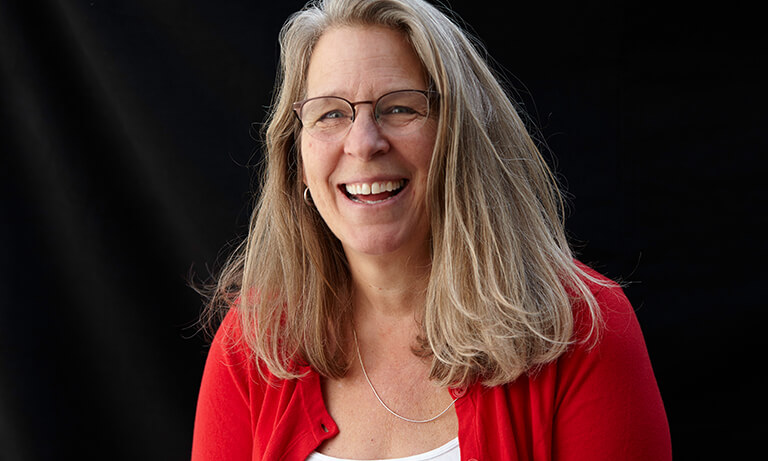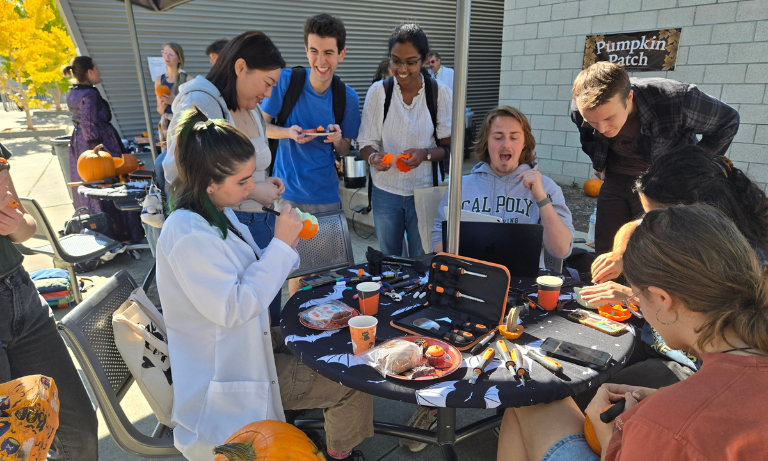General Engineering Director pursuing research, projects to put students, faculty at the center
General Engineering Director Liz Thompson is committed to altering our view of education.
Over her 30-year career at Cal Poly, Thompson has created a dynamic classroom where she engages an increasingly diverse set of students who come to Cal Poly with challenges as big as their dreams.
Outside the classroom, she has guided students as the director of women’s engineering programs, CENG associate dean, co-director of liberal arts and engineering studies, and currently as general engineering director.
Thompson now is taking the lessons she’s learned while championing students both inside and outside the classroom to make a difference on a higher level.
“My interest is always in institutional change, not fixing the students but the university as a whole,” Thompson said. “Instead of asking whether students are ready for the university, we need to ask if the university is ready for students.”
To this end, Thompson has joined colleagues from Cal Poly and beyond on research projects and programs that strengthen support for transfer students and faculty from underrepresented groups while challenging the traditional model of education.
“We have to advocate for a more diverse set of paths to a degree,” Thompson said.
ENGAGE
A collaboration between Cal Poly, Allan Hancock College and Cuesta College is providing one of those pathways for low-income, academically talented students transferring from neighboring community colleges into Cal Poly.
A National Science Foundation grant is funding the Engineering Neighbors: Gaining Access, Growing Engineers program through which 100 students receive scholarships and support as they move through community college and into Cal Poly, where they can obtain a degree for entry into the STEM workforce or graduate program.
The collaboration began in 2018, with funding to run through at least 2023.
Professor Jane Lehr from the College of Liberal Arts, who is the driving force of the grant, and Thompson are coordinating research activities at Cal Poly.
“I think it’s important that we do this work where we are located and with the students who are here,” said Thompson, who is an integral part of the research and mentoring effort at Cal Poly.
Part of the work involves outreach and aid for Hancock and Cuesta students so they can hit the ground running at Cal Poly.
“We want community college students to form an early connection to Cal Poly so they can find their identity within engineering as soon as they arrive,” said Thompson, adding transfers also are linked to extracurricular activities and clubs.
Throughout the program, students receive mentoring and financial assistance – an essential combination.
“Money for students who are typically under-resourced is super important but so is connecting students to the university and helping them create meaningful relationships with faculty,” Thompson said.
Her goal is to publish what the research team has learned about mentoring, social justice and engineering, while seeking further grant funding to continue the initiative and even expand to other CSU campuses.
ECO-STEM
During the 2019-20 academic year, Thompson taught at Cal State LA and collaborated on research around equity and social justice. She also teamed up with her Cal State and Cal Poly colleagues in 2020 to secure a four-year NSF grant for a project that aims to change the culture of teaching and learning at the university level.
The team of researchers believes the key is shifting the mental model of stakeholders to view education as an ecosystem, which values all individuals and their unique abilities.
“We are trying to change the way people think about education,” Thompson said.
In the current view, universities are like factories – moving students in an assembly-line style from class to class to deliver a “product” to industry. Efficiency and compliance are valued above the well-being of students, staff and faculty.
The ecosystem view, however, aspires toward an organic and healthy environment that nurtures students, staff and faculty to become individuals fulfilled professionally and personally, according to Thompson. The goal is to create a university that is “student-ready.”
“Relationships are important in this model,” she said. “We have to recognize that we are whole people who don’t just execute a job and go home.”
To drive the shift, the project has created various Eco-STEM communities at Cal State LA that bring together teachers, leaders and facilitators to reflect on issues ranging from social justice to systemic racism as they seek ways to propel a more diverse group into the STEM workforce.
Groups meet monthly as they focus on changing classroom culture along with the mental model of education.
Thompson runs a community of practice for department chairs, where she guides discussion and encourages reflective dialogue. She also is developing a survey that others can use to explore respondents’ views of the education system. The survey will be published sometime this summer.
“I know changing the mental model is a heavy lift, but I don’t want to stop because the well-being of our students matters,” she said.
KIND
Thompson believes creating more diverse campuses involves attracting and retaining women and under-represented groups in STEM faculties.
To that end, Cal Poly is teaming up with Fresno State, San Jose State and Cal State LA on the Kindling Inter-university Networks for Diverse Engineering project funded by the National Science Foundation.
The goal is to spark systemic change by increasing the number of women teaching engineering across the 19 CSU campuses, including those from under-represented groups and those who are foreign-born or foreign-trained.
Beyond hiring more engineering professors from those groups, efforts must be made to support them.
“We’ve found that mentoring is helpful and especially if faculty can connect others with the same background and research areas,” Thompson said.
Part of the project involves creating a dashboard that will display demographic data about faculty hiring and promotion in engineering colleges across the CSU system to identify barriers in recruitment and retention.
“It’s an important way to have data transparency,” said Thompson, who is hopeful more women will ultimately move into leadership positions on CSU campuses.
Having a more diverse group of thriving professors, including those from under-represented groups, is critical to the successful teaching and learning of all students in engineering classrooms, according to the project proposal.
“We are trying to build research networks across the CSUs with the idea that with more connections, a professor is more able to get things done, feel like they belong and are more likely to stay,” Thompson said.
Throughout her myriad research projects, Thompson remains dedicated to building an educational ecosystem that reflects and celebrates the diversity of its inhabitants.
“We have to change the university to be more accepting of a variety of paths and the people on them,” she said.
By Emily Slater


